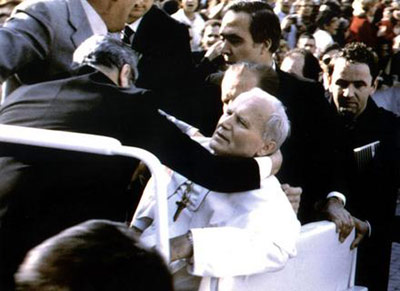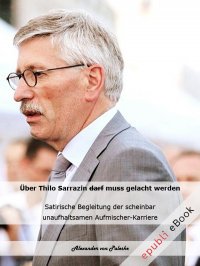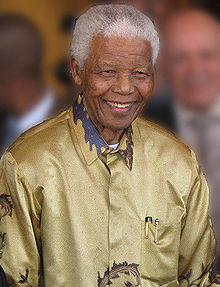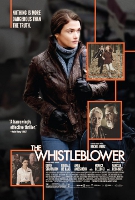Dark Side - Ali Agca's Secret Services
In a four-page article, written by Leszek Szymowski and consulted by Marek Lasota, a research fellow of the Polish Institute of the National Memory, the Warsaw-based weekly magazine (comparable to "Time") reports about new facts, confirming that the Soviet KGB planned and led all efforts to "eliminate" the Polish Pope, from 1978 up to 1989, when the Communist regime finally collapsed in Poland, and soon after in all Eastern and Central European countries of the former Soviet Bloc.

Ali Agca: Member and executor of the extreme-right Grey Wolves
New evidence is a crushing blow to all "conspiracy theories", invented by the Soviet disinformation experts or circulated in the West. These theories, disseminated by the communist propaganda machine all over the World, pointed to the extreme-right Grey Wolves organization in Turkey (of which Mehmet Ali Agca was member and executor), to the CIA (what for, while it was known that the CIA helped the Polish Pope) and to the Vatican itself (to put the blame on the political rivalry in the Holy See).
It is already known, beyond any doubt, that the Bulgarian secret services helped Agca in the execution of the attempt. New evidence, found in Berlin, in the archives of the East German communist secret service (STASI) confirms this conclusion. The East German intelligence was also allotted by the Kremlin a task to counter all reports and accusations against the Bulgarians. It looks like the Moscow-led efforts to get rid of the dangerous Pontiff were shared by other secret services of the Warsaw Pact countries and were well coordinated by the KGB. What was not known earlier, is the participation of the Polish secret services in the preparations for all plots.
The over-all picture of these assassination attempts (some 21-22 of them in total, from 1978 to 1989) is still dim. In spite of the 25 years since the May 13, 1981 assault made by Mehmet Ali Agca and probably one or more of his accomplices, the whole puzzle could not be put together. Only fragments of the truth are known. "The whole truth" — writes "Wprost" — could compromise not only the Soviet Union, but also the secret services of the satellite countries, including the Polish ones. These services wanted to reach the Pope and undercut his anti-communist crusade. Polish special services played a key part in this criminal plan."
"Operation Triangolo"
For a long time, this code-name used by the Polish special service (SB), was mistakenly linked to a singular provocation, led by a super-secret "Section D" of the SB in Cracow, in 1983. "Section D" was a special operations group, secretly organized in the Polish Ministry of Interior to carry out criminal operations against the Catholic Church. This particular action aimed at compromising a Cracow priest, Andrzej Bardecki, an editor of "Tygodnik Powszechny" weekly paper and one of the closest friends of Cardinal Karol Wojtyla, elected pope John Paul II. In 1983, special SB agents Grzegorz Piotrowski, Barbara Szydlowska and Barbara Borowiec (women agents) broke into the apartment of the priest and left there provocative materials. The provocation failed.
Only in 2005, the researches and investigators of the Polish Institute of National Memory (IPN) discovered that the "Operation Triangolo" embraced all hostile actions against the Pope, carried out by the Polish communist secret services. These findings were really shocking: it became evident that the assassination of John Paul II was the most important goal in the whole history of the communist special services in Poland. No other intelligence operation lasted so many years, involved so many people and used as big financial and other resources. The Polish communist services worked out a plan to kill the Polish Pope for at least four years. Fortunately, they scored no success.
The secret files, concerning the "Operation Triangolo" disappeared from the archives of the secret service (SB) in the Polish Ministry of Interior (the equivalent of the Home Office) on the 11th of April in the year 1989. A special delegation of the KGB officers came to Warsaw to secure and move out these documents. They are still kept as "top secret" in Moscow.
Imposimato: It was planned in Moscow
"It wasn’t done by Grey Wolves at all", a retired Italian Judge, Ferdinando Imposimato, told Wprost during his recent visit in Poland. He only repeated the words of Mehmet Ali Agca, whom he had questioned only hours after the May 13, 1981 attempt in Rome. Agca confirmed to him that he acted on behalf of the KGB. He added: "The Soviet Union directed my hand". As Richard Owen wrote in London’s "The Times" (January 10, 2006):
"Ferdinando Imposimato, the retired judge who led the initial inquiry and has since conducted his own research, said that 25 years after the shooting in St Peter’s Square on May 13, 1981, ‘many mysteries remain’. He told The Times that he remained ‘120 per cent convinced that the murder attempt was planned in Moscow’. […] ‘The Kremlin started to plot the Pope’s murder the moment he was elected in October 1978’ Signor Imposimato said."
A retired Italian judge, Imposimato, has no right to conduct an official investigation on his own. But he continues his private inquiry as one of the best informed officials, who participated in the investigation of Ali Agca and Sergei Antonov (a Bulgarian spy, released for lack of formal evidence for his part in the plot). He came to Poland to inspect the archives of the IPN and to meet Polish investigators, who plan to open an official investigation into the attempted murder of John Paul II, Karol Wojtyla, a Polish citizen.
SB-men on St Peter’s Square
In March 2005, archivists working in the Polish Institute of National Memory (IPN) found an interesting note, with information about a trip of an SB General, Zenon Platek, to Vienna, after April 3, 1979, for a 6 day’s meeting with a secret informant called "Tom". The trip was organized as part of the "Operation Triangolo". Researches of the IPN have examined the passports of the secret service (SB) officers, employed in the so called "4th Department" (an anti-Church unit) of the Ministry of Interior, from 1971 to 1989.

The results were very interesting. Usually one officer of this department traveled with pilgrims from Poland to Rome and attended a public general audience of the Pope. Only two times, three high officers of the SB attended Vatican public events: first time on the 22d of October 1978, during an inaugural pontificate Holy Mass, the second time on the 13th of May, 1981 — during the tragic general audience, when Agca was shooting at John Paul II. The names of these officers are known: Adam Pietruszka, Zenon Chmielewski and Jan Zacherowski, all employed in the 4th Department. They always used their service passports (perhaps also diplomatic passports were in use by some of these Polish communist spies).
In a document of the IPN, concerning "The travels out and in Poland of the employees of the 4th Department", there is also some evidence of the trips to Moscow for official meetings with representatives of the 5th Main Directorate of the KGB. Some notes from these meetings, fragmentarily conserved, indicate that these meetings were devoted to the planning of joint actions against the Catholic Church. Similar meetings took also place in Czechoslovakia. Usually, these meetings were attended by General Zenon Platek, then the Director of the 4th Department of the Ministry of Interior, his deputy, Colonel Adam Pietruszka and Captain Grzegorz Piotrowski, the head of the special "Section D".
IPN researchers are convinced that a decision to kill the Pope had been taken by the top KGB leaders during one of these meetings. Tactical operations were also decided about there, and tasks were allotted to the particular communist secret services. The Polish services claimed that, apart from the KGB, they had the best informers inside the Vatican.
Vatican’s ring of insiders
The attempt in St Peter’s Square on May 13, 1981, was the second known criminal act to attempt to murder John Paul II. The first occurred already in 1979, in the holy shrine city of Czestochowa, in Poland, when John Paul II celebrated a mass at Jasna Gora (a cloister with a holy painting of the Black Madonna, the most adored by the Polish Catholics). Some notes found in the SB archives testify that in 1979 a regional prosecutor investigated a case of placing explosives to detonate them when the Pope visited the Jasna Gora Church. This case was to be examined by a special SB team from Warsaw, under the command of General Platek. No documents of this case had ever been discovered.
In Rome and in the Vatican, a Polish communist spy-group began to invigilate the Pope and his close aides. The spies were supervised by General Zdzislaw Sarewicz, then the head of the 1st Department (Intelligence) of the Ministry of Interior. After the regime change in 1989, Gen. Sarewicz was officer and chief of the Intelligence Directorate of the State Protection Office (UOP), a new secret service. Until November 2005, he was still president of the Consultative Board of the Intelligence Seniors, serving the Chief of the Intelligence Agency.
Professional spies changed, working under diplomatic cover (like Colonel Adam Pietruszka) or even posing as agents of the Western services, like Andrzej Maczynski, code-named "Lakar", who was chief of the Polish intelligence station in Cologne and posed as officer of the West German intelligence, the BND. He had excellent contacts among the Polish clergy in the Vatican. And he recruited the most important (known until now) agent in the Vatican, a Dominical monk, Father Konrad Hejmo (code names "Hejnal", ‘Dominik" or "Vox").
Hejmo, whose longtime collaboration with the communist Polish intelligence has been recently discovered and made public by the IPN, was "duped" by Lakar and produced (until December 1, 1983) 17 large information sheets (115 pages). A part of his information, which was very important, concerned the policy of the Vatican and highly placed officials. His caretaker in Rome was the chief of the Rome Station of the Polish Intelligence, Major Edward Kotowski ("Pietro"), who also paid him money for his work "for the BND".
Father Hejmo’s reports were examined and evaluated by Colonel Tadeusz Grunwald, until 1982 the chief of the 4th Department’s Warsaw "Section D". In the 1990s, Grunwald became a businessman. An other agent, recruited by "Lakar" in the Vatican, was Father Piotr R., a close friend of John Paul II, code-named "Hrabia" (Count).
Italian secret services began to trace him as a possible communist informer. Polish SB service organized a disinfo action to turn the attention from Father Piotr to other persons. Father Hejmo was a voluntary informer, while Father Piotr R. was blackmailed to become one. The IPN is continuing the research to discover more Polish SB agents in the Vatican.
The Soviet communist secret services in Warsaw communicated directly with the KGB HQ in Moscow. One of the reports communicates: "Our friends [of the SB] dispose of a powerful operational force [agents] in the Vatican, which enables them to reach directly at the Pope and to the Rome Congregation…" This report has been made public by a Russian KGB defector, Vasilij Mitrokhin.
A failed journalist’s investigation
The attempt to assassinate the Polish Pope, on May 13, 1981, was a shock to the great majority of the Polish people. The Polish media was strictly controlled by the state censorship and only "approved" news and comments were released. In the early 1980s, I decided to do some research on my own. Working on the staff of a popular weekly paper and also for Polish Radio and the TV, I had a chance to travel to the countries of the Soviet Bloc, while my trips to the West had been cancelled by the secret services (SB).
In 1983, I decided to go to Sofia, and to interview two Bulgarian intelligence officers, Vasiliev and Ayvazov, who escaped from Italy after the attempt on the pope. I succeeded to meet them, but only Vasiliev granted an interview to me. Of course, he denied any Bulgarian involvement in the attempted killing. But he also told me that he was very depressed, because many people associated him with Agca and the attempt, and his family was suffering because of this situation.
Then, I was asked to write an epilogue for a book on the attempt, which was originally published in France. My text was heavily censored, but some hints were left about the future of the investigation. When I was in Hungary, some Hungarian intelligence officers (with whom I worked in South Vietnam in 1973) told me they had doubts about the official outcome of the Agca trial. They told me Agca could not work alone, and Bulgarians helped him. Choosing an extreme right-wing killer was a purposeful choice of the Soviet KGB.
Then, in 1987, I was arrested as a "spy" and put to jail for 8 years in Poland, after a secret trial by a Warsaw Military Tribunal. While in a communist jail, in Barczewo near Olsztyn (North-Eastern Poland), serving my sentence in a special prison ward, I incidentally met…Colonel Adam Pietruszka of the SB. Pietruszka, who was serving his 25 year’s sentence for his alleged part in the brutal murder of a "Solidarity" chaplain, priest Jerzy Popieluszko (beatificated by John Paul II, after his death as a martyr). The chief of the killers’ squad was Major Grzegorz Piotrowski, the former chief of "Section D" in Cracow. Pietruszka, who has been already released from jail and who told me in 1989 about his work in Rome, under a diplomatic cover, developing secret SB agents in the Vatican. He also told me that many high priests in Poland and in the Vatican did not believe in his participation in Popieluszko’s murder. He said that Piotrowski was "out of control" and probably cooperated with the KGB. I couldn’t verify his claims.
I traveled to the USSR many times, in the 1970s and 1980s. Each time, Soviet officials asked me about the Pope and they regretted that John Paul II was still alive and active. My efforts to get out any details, concerning the May 13, 1981 attempt, produced no results. One time I was warned that if I continued to ask questions, I might never return home.
In 2005, I tried to reach Sergei Antonov in Sofia, Bulgaria, and interview him. But my Bulgarian journalist friends told me Antonov was insane, and in a psychiatric ward. True or not, he was fed special medicaments to "forget". The KGB developed at least equal methods of mind control, as the CIA, or even better. Bulgaria is still under a Russian supervision, though a candidate-state to join the EU soon.
The 20-21 attempts on the life of the late Pope, John Paul II, still remain a mystery unsolved. "Wprost" ends the article by a description of the pope’s meeting with Agca in a Rome prison, in 1982. The cameras of the Italian TV, filming the scene from a distance, recorded a moment, when John Paul II, after a short conversation with Agca, covered his face with the palms of his hands. He seemed to be very upset but calmed down and said to his would-be-killer: "What we told each other, that will remain our secret" — he told the journalists. Did Agca reveal to the Pope who ordered to kill him? Did he point to the Polish accomplices? We shall never know.
In Poland, Judge Imposimato met with Polish researchers and investigators and examined some documents in the IPN. A final decision to begin an official investigation into the attempt at the life of the Polish Pope has not been made yet. But it is being considered by the Polish authorities the head of the investigative section of the IPN, Professor Witold Kulesza, told `Wprost’.
sfux - 12. Okt, 08:03 Article 10897x read
















































